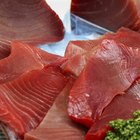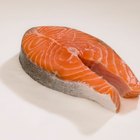
deymos/iStock/Getty Images
Swordfish are a large game fish that are coveted for their rich, meaty fillets and steaks. These fish are found in warm and temperate waters worldwide, according to Vin T. Sparano, author of "The Complete Outdoors Encyclopedia." One flavorful and healthy way to prepare swordfish is to grill it on a cedar plank. The cedar infuses the meat with a savory, smoky flavor.
Nutrition
Swordfish are a nutritious option if you are seeking a fish filled with healthy fats. These fish are a good source of vitamin B-12, vitamin B-6, niacin, phosphorous and selenium, according to the HealthALiciousNess.com nutrition database. Grilling swordfish is a healthy way to prepare it because it does not add additional fats, such as cooking oil, to the meal. Avoid topping your grilled swordfish with creamy or sugary sauces to prevent adding unnecessary fat and calories to the meal.
Selecting
Swordfish steaks are the best option for grilling on a cedar plank because they will remain juicy on the high heat of the grill. Select steaks that are at least 1 inch thick. If you are purchasing fresh swordfish steaks, look for firm steaks that spring back when you press on them. The steaks should not have a strong fishy odor. Strong odors can indicate that the fish is old or not fresh. If you can't find fresh swordfish, purchase frozen steaks and thaw them in the refrigerator overnight.
Grilling on Plank
Purchase a cedar plank from a cooking specialty store or from an online retailer. One plank should be large enough for two swordfish steaks. Heat the grill to 450 degrees Fahrenheit, or high. Brush the plank with enough olive oil to coat the top surface, and place the plank on the grill. Position the swordfish steaks on the plank so they are not touching. Grill the steaks for 20 minutes, or until they are moist and cooked to your desired temperature. Do not turn the steaks.
Serving Suggestions
Cedar plank-grilled swordfish has a robust, smoky flavor that matches well with the bright flavors of a citrus salsa, such as a mango salsa, or a tropical fruit salad. Alternatively, serve the fish with a side of pasta in a light sauce, such as a tomato-based primavera sauce. The flavor of the fish is strong enough to stand on its own. You will not need any additional sauces or seasonings on the fish except for salt and pepper to taste.
Related Articles

How to Cook Sculpin Fish

How to Cook a Steak on a Plank

How to Cook Antelope

How to Cook Belt Fish

How to Cook Yellowfin Tuna on a George ...

How to Cook Mackerel in an Oven
How to Cook Cobia

How to Cook Swai White Fish on the Grill

How to Pan-Sear Swordfish

Substitutes for a Tuna Steak

How to Pan Cook Shark

How to Grill a Ribeye on a Weber Q

How to Cook Ahi Tuna on a Frying Pan

How to Cook Swai With Breading
How to Cook Goat Steak

How to BBQ Salmon Fillets

How to Cook Rockfish Fillets

How to Smoke Tuna

How to Cook Jamaican Jerk Salmon

How to Grill Tuna Steak
References
Writer Bio
Natalie Smith is a technical writing professor specializing in medical writing localization and food writing. Her work has been published in technical journals, on several prominent cooking and nutrition websites, as well as books and conference proceedings. Smith has won two international research awards for her scholarship in intercultural medical writing, and holds a PhD in technical communication and rhetoric.
Photo Credits
deymos/iStock/Getty Images